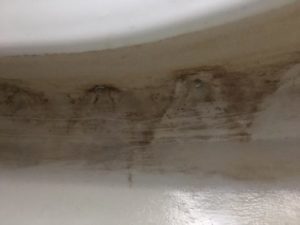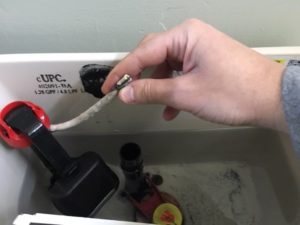A slow flushing toilet is extremely common, so don’t be surprised if you begin to notice that your toilet is flushing with less power than it used to. The problem is annoying and often requires a second flush by the user.
A second flush wastes water and cost money, so your best bet is to solve the problem by fixing your toilet.
Understandably, your first thought will be a clog and you may be right. However, a slow flushing toilet can be the result of a few other problems that you can fix fairly easily.
Thankfully, there’s no need to get a new toilet and no need to call a plumber.
I know toilets, and every few years I’ll notice my toilet is flushing slowly. I have a mental checklist that I go through and I’ll share it with you today.
It’s time to get out the DIY gloves and fix your slow flush.
Double Check The Water Line When The Tank Is Filled
Did you know that you can set the water level inside your tank? The water level plays an important role in how much water each flush uses.
Setting the water level an inch lower can save a lot of water (and money) over time while setting the water level higher will use more water but also provide a stronger flush.
To save water and money, you might be tempted to set the water level in the tank lower. But know this: if the water level is too low, the flush won’t be powerful.
Adjusting the water level is easy but it depends on the type of float you have.
If you use a balloon float, simply bend the arm higher or lower to adjust the water level. If you have a more modern float, you’ll likely use a screwdriver to adjust the position of the float on the fill valve.
Here’s a video that helps with adjusting the water level in your toilet.
Has The Slow Flushing Toilet Occurred For A Long Time?
If you notice you slow flush began months ago, it may be due to other build up in the toilet. One of the most common problems I’ve seen is a calcium build-up in and around the bowl.
If you’re in an area with hard water, calcium may have built up inside the bowl. You can fix this, but before doing the next steps, make sure you turn the water off and flush the toilet.
To do this, look behind the toilet and you should see a nozzle with a water line that connects the wall to the toilet. Turn it to the right and the water is off.
Flush the toilet and the tank shouldn’t refill.
-
Look For The Small Holes Inside The Rim Of The Bowl

You’ll need a strong wire (wire clothes hanger) to clean the water holes on the inside of the toilet bowl. The water holes are located under the edge of the toilet bowl. They are small and you’ll need to stick your head in the toilet to find them.
Very gently, insert the end of the wire clothes hanger in each hole and wiggle it around. Move it in and out to loosen the hole. It will help remove hard water build up.
There will be many small holes around the bowl. Do this to each hole.
This simple method usually improves flushing, however, we’re going to add another step to make sure the tank and bowl are clean.
-
Fill The Tank With .5 Gallons Of Vinegar and Another .5 To The Bowl
You’ve finished clearing the holes in the bowl and the water is still turned off (the tank and bowl should be mostly empty).
Buy a 1-gallon bottle of vinegar (they only cost a couple bucks). Pour .5 gallon of vinegar into the tank and another .5 into the bowl.

Find the tube going into the overflow valve and pour a small amount of vinegar into the rubber tube and let sit.
Let it sit for 2-3 hours then flush the toilet.
After the first flush, the vinegar will enter the holes around the bowl and it will enter the pipes beneath the toilet.
Let sit for several more hours (2-5 hours, the longer the better) before flushing a 2nd time.
Make sure to reattach the rubber tube inside the overflow valve and turn the water nozzle on behind the toilet.
This method usually works great for slow flushing toilets and only requires a few dollars for vinegar. Bleach can also be used although I find vinegar works just as good without the harsh chemical smell.
Did Your Slow Flushing Toilet Occur Recently?
If your slow flushing toilet occurred recently, it’s likely due to build-up in your pipes. You’ll want to push water through the pipes in order to loosen up the clog. I have a few go-to methods to clear the pipes in my toilets.
-
The first method is with a 5-gallon bucket
Why do you need a bucket? Well, a bucket can be filled with water and dumped into the bowl. It forces a significant amount of water through the pipes (much more than a flush could).
Most households have a bucket for cleaning or for yard work. Bring the empty bucket in the bathroom and use the bathtub to fill it ¾ full. It will be heavy so bend your legs and use caution when picking it up.
Prepare your toilet by lifting up the lid and seat and laying old towels around the toilet on the floor (they shouldn’t get wet but the towels are perfect for splash). Standing over the toilet, pour the bucket of water into the bowl and empty the bucket of water. It should be completely poured into the bowl in one motion and you should observe a flush (learn how to flush a toilet without running water).
You might want to do this multiple times if you’re certain it’s a clog. Professional tip: use extra hot water in the bucket and add a little dish soap to unclog stubborn pipes.
-
Plunger
The plunger is a classic way to unclog a toilet and it may help make your flushes more powerful. The plunger can be used on its own, or you could follow up the bucket method with the plunger.
Using a plunger helps force water through the pipes, however, it takes some effort to really get a good suction. I wrote an article about using a plunger that you can read here.
-
Toilet Auger/Snake
The last tool you can try if you think your slow flush is caused by a clog is a toilet auger. An auger is a long thin tool that reaches into the toilet’s trap. It can help loosen material that is causing the clog. It won’t reach the sewer lines under the house, but it can help with clogs near the toilet.
Most households don’t have a toilet auger, but they are a good tool to have for clogs. Buying one can pay for itself because you will save on the cost of a plumber for clogs (my article on using a toilet auger).
Conclusion
A slow flushing toilet can be strange. Over time you might notice that your toilet isn’t working like it once was. You may think it’s something you did, or you might think you need a new toilet.
You’ll be happy to know that it happens a lot, especially in areas with hard water. Hard water can cause build up in your toilet and pipes. Vinegar can help eat away at the build-up, but you’ll need to do some work as well.
The number 1 place I recommend cleaning is under the rim of the toilet bowl. You’ll need a wire hanger that can fit in the hole and loosen debris. There are many holes that feed water into the bowl, so take your time and clean out each one.
Using vinegar in the tank and bowl will help to degrade build-up as well. After a few hours, flush one time and allow the vinegar to work it’s magic in the pipes as well. If possible, let it soak overnight before flushing again.
A new toilet is expensive and so is a visit from the plumber. The tips I mentioned in this article will only cost a few dollars and a couple hours of your time, so they will save you money!
Bleach and other strong chemicals can be used, but I always advise to use natural products when possible. If you have young children in your home, or weak ventilation, I strongly recommend using a product like vinegar because it’s natural and relatively harmless.
Thanks for reading another Toilet Travels article. Find more tips, tricks, and DIY fixes for the toilet on the homepage. I do my best to answer every toilet question you have!

